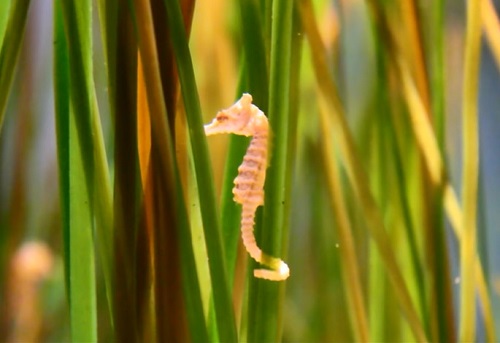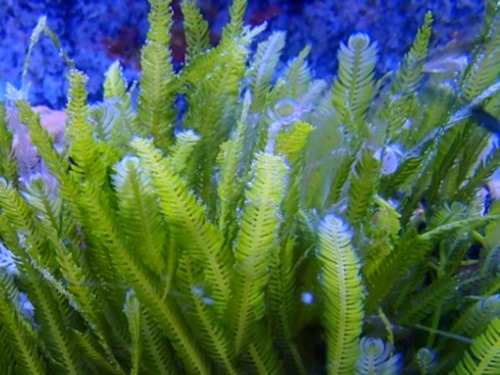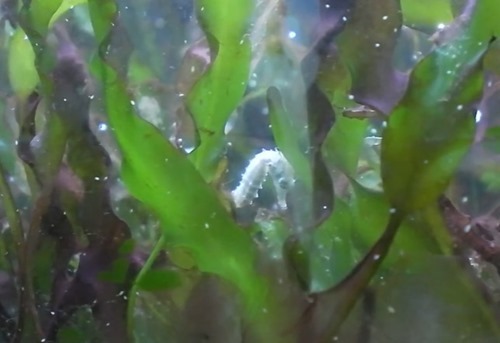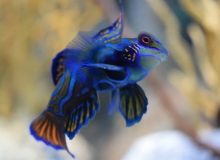Tiny Tails, Big Needs: The Complete Guide to Dwarf Seahorse Care
Delicate, enchanting, and no bigger than a paperclip—the dwarf seahorse is nature’s miniature masterpiece. Unlike their larger cousins, these tiny creatures captivate aquarists not with bold colors or dramatic size, but with their quiet charm and mesmerizing movements. Watching a dwarf seahorse wrap its tail around a piece of seagrass or gently sway with the current feels like witnessing a living poem.
But don’t let their tiny size fool you—keeping dwarf seahorses isn’t a casual endeavor. Their slow, methodical lifestyle and specialized needs mean they require a tank tailor-made for them. From choosing the right tankmates (or none at all), to feeding live food daily and avoiding powerful filters that could sweep them away, these seahorses demand attention, patience, and care.
In this comprehensive guide, we’ll cover everything you need to know to create a safe, thriving environment for your dwarf seahorses—so you can enjoy the magic of the ocean’s smallest steed right in your living room.
- Quick Care Stats
- Species Overview
- Appearance
- Tank Requirements
- Tank Setup
- Diet and Feeding
- Tank Mates
- Breeding
- Diseases & Treatment
- Buying Healthy Dwarf Seahorses
- Acclimating Dwarf Seahorses to the Aquarium
- Frequently Asked Questions (FAQs)
Quick Care Stats
- Scientific Name: Hippocampus zosterae
- Common Name: Dwarf Seahorse, Pygmy Seahorse
- Origin: Western Atlantic (Gulf of Mexico, Bahamas, Florida)
- Max Length: 1 inch (2.5 cm)
- Minimum Tank: 3 gallons (11 liters)
- Stocking: 2–4 pairs per 5 gallons; limited tankmates
- Temperament: Peaceful, delicate
- Feeding: Carnivorous; live copepods, baby brine shrimp
- Breeding: Live-bearer; males carry eggs, moderate difficulty
- Habitat: Seagrass beds, shallow coastal waters
- Tank Setup: Low flow, seagrass or artificial hitching posts, live rock
- Active Tank Levels: All levels, prefers mid to bottom
- Temperature: 72–78°F (22–26°C)
- pH: 8.1–8.4
- Water Hardness: Specific gravity 1.020–1.025
- Lifespan: 1–2 years
Species Overview

Dwarf Seahorses inhabit the seagrass-rich coastal waters of the Western Atlantic, particularly in regions like the Florida Keys, the Bahamas, and the Gulf of Mexico, where they anchor to seagrass, macroalgae, or other structures in shallow, calm environments.
Measuring up to 1 inch (2.5 cm), they are among the smallest seahorse species, making them ideal for nano marine tanks of 3–10 gallons. Their horse-like shape, prehensile tails, and ability to change color for camouflage create a mesmerizing display in well-designed setups.
Dwarf Seahorses are peaceful but delicate, requiring meticulous care, including pristine water quality and a steady supply of live food. Their unique behaviors, such as clinging to hitching posts and performing intricate courtship dances, make them a favorite among marine hobbyists willing to meet their demanding needs.
Appearance
Dwarf Seahorses are instantly recognizable for their miniature, equine-like form, which blends seamlessly with their seagrass habitats. Key features include:
Base Color: Their coloration varies from green, yellow, to brown, often matching the seagrass or macroalgae in their environment. They can change color slightly to blend in, enhancing their camouflage against predators or during courtship.
Fins: A tiny, transparent dorsal fin provides gentle propulsion, fluttering rapidly to maneuver. They lack a caudal fin, relying instead on their prehensile tail to anchor to seagrass, macroalgae, or other structures.
Body Shape: Their upright, horse-like body features a curved neck, small snout, and expressive eyes. The prehensile tail allows them to grip hitching posts securely, enabling their characteristic slow, deliberate movements.
Sexual Dimorphism: Males are distinguished by a prominent brood pouch on their abdomen, where they carry developing embryos. Females lack this pouch and are slightly slimmer, with a more streamlined appearance.
Size: Growing up to 1 inch (2.5 cm), Dwarf Seahorses are among the smallest marine fish, making them perfect for detailed nano aquariums where their delicate features shine.
Additional Notes on Appearance
Their coloration is highly adaptable, influenced by diet, tank environment, and stress levels. In tanks with green macroalgae or seagrass, they may adopt vibrant green hues, while brown or yellow tones dominate in other setups. Stress or poor water quality can dull their colors, so maintaining optimal conditions is key to showcasing their beauty.
Tank Requirements
A minimum tank size of 3 gallons is sufficient for a single pair of Dwarf Seahorses, but a 5–10-gallon tank is ideal for 2–4 pairs, allowing space for hitching posts and stable water conditions. Due to their high bioload and sensitivity to water quality, stock conservatively, aiming for 1 pair per 2–3 gallons. Stable marine water parameters are critical:
- Temperature: 72–78°F (22–26°C)
- pH: 8.1–8.4
- Specific Gravity: 1.020–1.025
- Ammonia/Nitrite: 0 ppm
- Nitrate: <10 ppm
A tight-fitting lid is essential to prevent escapes, as Dwarf Seahorses may climb or jump when stressed or exploring. Daily water testing with a marine-grade test kit is recommended to ensure stability, with weekly water changes of 20–30% using a high-quality marine salt mix. Avoid sudden parameter changes to prevent stress, which can be fatal for these delicate fish.
Tank Setup

To replicate their natural seagrass bed habitat, design a tank with ample hitching posts and minimal water flow. Use artificial seagrass, gorgonians, or macroalgae like Caulerpa or Chaetomorpha to provide anchoring points, as Dwarf Seahorses rely on their tails to grip structures. Live rock can enhance natural filtration and aesthetics, hosting beneficial microorganisms while offering additional hitching surfaces. A fine sand substrate or bare-bottom tank simplifies cleaning, as uneaten food and waste must be removed promptly to prevent ammonia spikes.
A gentle sponge filter or an under-gravel filter with minimal flow is ideal, as strong currents can dislodge seahorses or stress them. A reliable heater maintains stable temperatures, as fluctuations can weaken their immune systems. Marine-grade lighting, such as low-to-moderate LED systems, supports macroalgae growth while avoiding excessive brightness that may stress seahorses. Floating plants or macroalgae can diffuse light, creating a shaded, naturalistic environment.
Additional Setup Considerations
- Hitching Posts: Provide a variety of hitching options (e.g., plastic seagrass, branching macroalgae) spaced throughout the tank to allow each seahorse to claim a territory.
- Maintenance: Siphon uneaten food and debris daily during feedings to maintain pristine water quality. Regularly trim macroalgae to prevent overgrowth while preserving hitching areas.
- Water Quality: Use only reverse osmosis/deionized (RO/DI) water mixed with a marine salt mix to ensure proper salinity and avoid contaminants.
Diet and Feeding

Dwarf Seahorses are obligate carnivores with tiny snouts adapted for consuming small, live prey. Their specialized diet and slow feeding habits require a consistent supply of appropriately sized food. Recommended foods include:
- Live Foods: Newly hatched brine shrimp (Artemia nauplii) and copepods (e.g., Tisbe or Apocyclops species) are ideal, as their small size suits the seahorses’ narrow snouts. Copepods are preferred for their high nutritional value and natural movement, which stimulates feeding.
- Frozen Foods: Frozen foods like mysis shrimp or copepods are rarely accepted due to their lack of movement, making live foods essential. If attempting frozen foods, use a feeding station and gentle water flow to mimic live prey motion, but success is not guaranteed.
- Feeding Frequency: Feed 2–3 times daily, ensuring a steady supply of live prey is available in the tank. Target feed by releasing copepods or brine shrimp near hitching posts to ensure seahorses can access them without competition.
- Copepod Culture: Maintaining a separate copepod culture tank (2–5 gallons) is often necessary to provide a consistent food supply. Seed the main tank with copepods regularly to sustain a population that seahorses can graze on.
Feeding Tips
- Use a turkey baster or pipette to deliver live food directly to seahorses, minimizing waste and ensuring shy individuals eat.
- Monitor feeding to confirm all seahorses are consuming enough, as stronger individuals may dominate food sources. If necessary, isolate weaker seahorses during feeding.
- Avoid overfeeding, as excess live food can die and decompose, spiking ammonia levels. Siphon out uneaten prey after 10–15 minutes to maintain water quality.
A reliable live food supply is critical to prevent starvation, as Dwarf Seahorses have high metabolisms and cannot survive long without food.
Tank Mates
Behavior and Temperament
Dwarf Seahorses are peaceful but extremely delicate, moving slowly by anchoring to hitching posts with their prehensile tails. Their shy nature and slow feeding habits make them easily outcompeted for food, requiring a tank environment tailored to their needs. They exhibit minimal aggression but may become stressed in the presence of fast-moving or dominant tankmates. Their unique swimming style—propelled by rapid dorsal fin movements—makes them vulnerable to disturbance, so a calm, low-traffic tank is essential.
Suitable Tankmates
Due to their fragility, minimal tankmates are recommended to avoid competition or stress. Compatible options include:
- Fish: Tiny, non-aggressive species like pipefish (Syngnathus spp.) or small gobies (Eviota or Trimma species) may coexist, as they occupy similar niches without competing aggressively. Avoid fast-moving or schooling fish that may disrupt seahorses.
- Invertebrates: Small cleanup crew members, such as micro hermit crabs (Clibanarius spp.) or nerite snails, are safe and help manage algae and detritus. Avoid larger crabs, shrimp (e.g., peppermint shrimp), or predatory invertebrates that may harass or eat seahorses.
- Corals: Soft, non-stinging corals like Xenia or Clavularia can work as hitching posts, but avoid stinging corals (e.g., anemones, LPS corals) that may harm seahorses.
Tankmate Considerations
- Limit tankmates to reduce competition for food, as seahorses are slow feeders and easily outcompeted.
- Monitor interactions closely, as even peaceful tankmates may inadvertently stress seahorses by consuming copepods or disturbing hitching posts.
- Avoid overcrowding, as high bioloads from additional tankmates can degrade water quality, which is particularly harmful to seahorses.
Breeding
Preparation for Breeding
Breeding Dwarf Seahorses is moderately achievable in captivity with meticulous preparation, as they are prolific breeders under optimal conditions. Set up a dedicated 5–10-gallon breeding tank with abundant hitching posts (e.g., artificial seagrass, Caulerpa, or spawning mops) to provide spawning sites. Maintain stable water parameters to encourage breeding:
- Temperature: 74–76°F (23–24°C)
- pH: 8.1–8.3
- Specific Gravity: 1.020–1.023
- Water Quality: Ammonia and nitrite at 0 ppm, nitrates below 10 ppm.
Condition a breeding pair (one male to one or two females to reduce competition) with abundant live copepods and newly hatched brine shrimp for 1–2 weeks to enhance health and reproductive success. Use a gentle sponge filter to maintain water quality without disturbing eggs or fry, and ensure a secure lid to prevent escapes. Dim lighting and dense hitching posts reduce stress during courtship and spawning.
Breeding
Males initiate courtship with a “dance,” bobbing and intertwining tails with females while displaying brighter colors. During mating, the female transfers eggs to the male’s brood pouch via an ovipositor, where they are fertilized and incubated. Gestation lasts 10–14 days, depending on temperature, after which the male releases 5–20 tiny fry, each a miniature replica of the adult. The fry are independent but highly vulnerable. To prevent predation, remove the adults to the main tank post-spawning, or transfer fry to a separate rearing tank. Eggs are small and scattered, often clinging to hitching posts, making collection challenging but unnecessary if the breeding tank is fry-safe.
Caring for Fry
Fry are born fully formed but extremely small (2–3 mm), requiring specialized care in a dedicated rearing tank:
- Initial Feeding: For the first 5–7 days, feed live rotifers, copepod nauplii, or commercial liquid fry food designed for marine fry. After 7–10 days, transition to newly hatched brine shrimp or copepods as they grow.
- Nursery Tank: Use a 2–5-gallon bare-bottom tank with gentle aeration and fine hitching posts (e.g., thin plastic grass or Caulerpa). Maintain identical water parameters to the breeding tank, with daily 10% water changes using RO/DI water and marine salt mix to ensure stability.
- Growth and Development: Fry grow slowly, reaching about 0.5 inches (1.2 cm) in 6–8 weeks. Provide constant access to live food, as they cannot survive without frequent feeding. Monitor for cannibalism and separate larger fry if necessary.
Raising fry is challenging due to their size and dietary needs, but a well-maintained copepod culture and pristine water conditions significantly improve survival rates.
Diseases & Treatment
Dwarf Seahorses are highly sensitive to poor water quality and stress, which can lead to health issues. Common problems and treatments include:
Bacterial Infections: Symptoms include swollen or inflamed brood pouches (in males), lethargy, or skin lesions. Treat with marine-safe antibiotics (e.g., Seachem NeoPlex or Kanaplex) following manufacturer instructions, and perform 25–30% water changes to improve water quality. Remove carbon from filters during treatment and complete the full course to prevent resistance.
Gas Bubble Disease: Indicated by bubbles in the male’s brood pouch or under the skin, often caused by supersaturated gases or poor water conditions. Reduce water agitation, check for gas supersaturation (e.g., from faulty equipment), and consult an aquatic veterinarian for pouch evacuation if severe. Maintain stable parameters to prevent recurrence.
Starvation: Signs include weakness, thinness, or sunken abdomens, resulting from insufficient live food. Ensure a constant supply of copepods or brine shrimp, and seed the tank with copepods to allow grazing. If starvation persists, isolate affected seahorses and target-feed multiple times daily.
Prevention
Prevent health issues with diligent care:
- Perform daily water quality checks and 20–30% weekly water changes using RO/DI water and a marine salt mix to maintain pristine conditions.
- Monitor specific gravity, ammonia, nitrite, and nitrate levels with a marine test kit to ensure stability.
- Provide a continuous supply of live food to prevent starvation, and siphon uneaten prey to avoid water fouling.
- Quarantine new seahorses, plants, or tankmates for 2–4 weeks to prevent introducing pathogens.
- Minimize stress by avoiding sudden lighting changes, loud noises, or aggressive tankmates.
Regular observation and immediate action at the first sign of illness are critical for these delicate fish.
Buying Healthy Dwarf Seahorses
Selecting healthy Dwarf Seahorses is critical to ensure their survival and long-term success in your aquarium. Their delicate nature and specific care requirements make it essential to source them from reputable suppliers and follow proper acclimation protocols. Below are key considerations for purchasing healthy specimens:
Wild-Caught vs. Captive-Bred
Captive-Bred: Strongly preferred, as captive-bred Dwarf Seahorses are far less likely to carry diseases or parasites. They are typically hardier, better adapted to aquarium conditions, and come with known histories (e.g., age, diet). Captive-bred seahorses are more expensive but offer greater assurance of health and compatibility with tank life. Look for breeders or suppliers specializing in seahorses, such as those certified by organizations like the Marine Aquaculture Council.
Wild-Caught: Riskier due to potential exposure to pathogens, parasites, or stress from capture and transport. If considering wild-caught seahorses, verify that the seller has quarantined and treated them for diseases and parasites, a standard practice among reputable suppliers. Ask for details on quarantine duration (ideally 2–4 weeks) and treatments used (e.g., antiparasitic or antibiotic protocols). Avoid sellers who cannot provide this information.
Evaluating Health
When purchasing Dwarf Seahorses, inspect them carefully (in-person or via detailed photos/videos from the supplier) for signs of good health:
Appearance: Healthy seahorses have bright, consistent coloration (green, yellow, or brown, depending on their environment) and are actively clinging to hitching posts or swimming. Avoid seahorses with faded colors, sunken abdomens, or lethargy, as these indicate stress or starvation.
Behavior: Look for alert, responsive seahorses that react to their surroundings (e.g., turning their heads or moving their tails). Avoid those that are floating listlessly or failing to anchor, as this may signal weakness or illness.
Body Condition: Ensure the seahorse has a plump abdomen (not pinched or thin) and no visible wounds, lesions, or bubbles under the skin (indicative of gas bubble disease). Males should have a smooth, uninflamed brood pouch.
Eating Habits: Ask the seller to confirm that the seahorses are actively feeding on live copepods or brine shrimp. Request documentation or video evidence of feeding, as seahorses that refuse food may be stressed or unhealthy.
Acclimating Dwarf Seahorses to the Aquarium
Proper acclimation is crucial to reduce stress and ensure a smooth transition to your tank. Dwarf Seahorses are more sensitive than most marine fish, requiring a slow and careful process. The following method, adapted from reputable seahorse suppliers, has proven effective:
- Pre-Acclimation Check: Before opening the shipping bag, confirm your tank’s water parameters are within the ideal range: temperature 72–78°F (22–26°C), pH 8.1–8.4, specific gravity 1.020–1.025, ammonia/nitrite 0 ppm, and nitrates <10 ppm. Ensure the tank has ample live copepods and hitching posts.
- Temperature Equalization: Float the sealed bag in the aquarium for 10–15 minutes to equalize the temperature between the bag and tank water. Avoid direct light exposure to minimize stress.
- Initial Water Introduction: Partially open the bag and add 1/2 cup (120 mL) of tank water. Secure the bag to the tank’s edge to prevent spilling.
- Wait Period: Allow 10 minutes for the seahorses to adjust to the mixed water.
- Gradual Water Exchange: Remove 1/2 cup of water from the bag (discard it, do not add to the tank) and add another 1/2 cup of tank water. Wait another 10 minutes.
- Repeat Exchange: Repeat the water removal and addition process one more time, waiting 10 minutes between steps. This gradual process adjusts the seahorses to your tank’s salinity and chemistry.
- Transfer to Tank: Do not use a net, as it can damage their delicate tails or bodies. Gently scoop each seahorse by hand or with a small, clean container, and carefully place them near a hitching post in the tank. Discard the remaining bag water to avoid introducing shipping water to your system.
- Post-Acclimation: Dim the tank lights and minimize disturbances for 24–48 hours. Offer live copepods immediately to encourage feeding, and monitor for signs of stress (e.g., failure to anchor, refusal to eat).
Acclimation Tips
- Quarantine: If possible, acclimate seahorses in a separate quarantine tank for 2–4 weeks to monitor for diseases or parasites before introducing them to the main tank. This is especially critical for wild-caught seahorses.
- Observe Closely: Watch for normal behavior (e.g., anchoring to hitching posts, active feeding) within the first few hours. If seahorses appear lethargic or refuse food, double-check water parameters and increase copepod density.
- Avoid Rushing: The entire acclimation process should take 30–45 minutes to ensure minimal stress. Rushing can lead to osmotic shock or health decline.
By sourcing healthy, preferably captive-bred Dwarf Seahorses from reputable suppliers and following careful acclimation procedures, you can maximize their chances of thriving in your nano marine aquarium. Their delicate nature requires vigilance, but their unique beauty and behaviors make the effort worthwhile for dedicated aquarists.
Frequently Asked Questions (FAQs)
Q: Can Dwarf Seahorses live in a freshwater tank?
A: No, they are strictly marine and require a saltwater environment with specific gravity of 1.020–1.025. Freshwater will cause rapid health decline and death.
Q: Do they need live food?
A: Yes, live copepods or newly hatched brine shrimp are essential, as their small snouts and feeding habits make frozen or dry foods largely unsuitable.
Q: Are Dwarf Seahorses good for beginners?
A: No, their specialized diet, sensitivity to water quality, and delicate nature make them best suited for experienced marine aquarists with access to live food cultures.
Q: How many Dwarf Seahorses can I keep in a 5-gallon tank?
A: 2–4 pairs (4–8 individuals) is feasible, provided water quality is pristine, live food is abundant, and hitching posts are plentiful. Overstocking risks poor water quality and stress.
Q: How long do Dwarf Seahorses live?
A: With optimal care, they can live 1–2 years, though pristine water conditions, a robust food supply, and low stress can extend their lifespan slightly.
Q: Can Dwarf Seahorses be kept with corals?
A: Yes, but only with soft, non-stinging corals like Xenia or Clavularia that can serve as hitching posts. Avoid stinging corals like anemones or LPS corals, which can harm seahorses.
Q: How often do Dwarf Seahorses breed?
A: Under ideal conditions with abundant food and stable parameters, males can carry broods every 2–4 weeks, producing 5–20 fry per gestation, though raising fry is challenging.


Leave a Reply